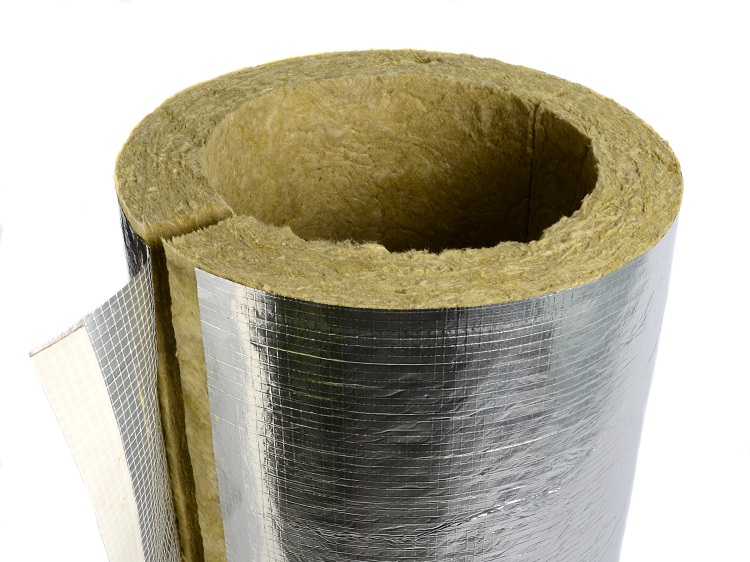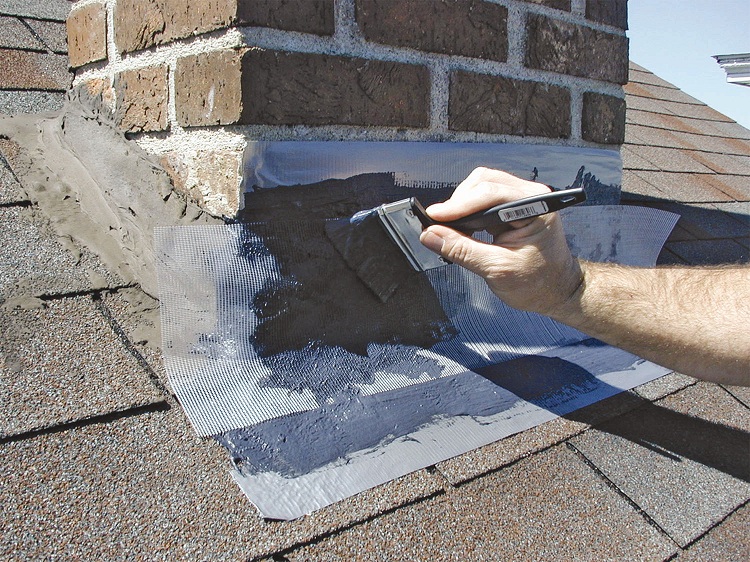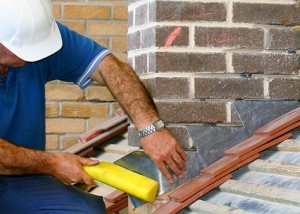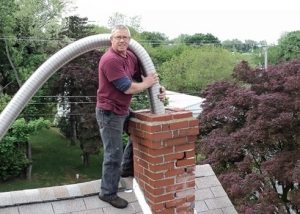The chimney is a subtle, but very important part of a private house. He is being unfairly deprived of the proper attention, and often they completely forget to allocate time for repairs or quality service. They recall the chimney when serious problems already arise. When exposed to wind and precipitation, the design of the smoke exhaust system begins to gradually deteriorate. However, timely insulation of the chimney will increase its service life.

Thermal insulation of the chimney pipes can be done by different methods using the most convenient materials
Content
The need for thermal insulation
The expediency of insulation is due to several reasons.
- thermal insulation of the chimney prevents its rapid cooling. Accordingly, the heat in the house persists for a longer period of time;
- thermal insulation prevents heating of the home construction;
- perhaps the most compelling reason is the accumulation of condensate in the insulated chimney, the impact of which destroys the design of the chimney. This problem concerns not only stove heating systems, but also modern gas boilers.
During the operation of the stove or fireplace in the chimney, oxygen vapor accumulates. With decreasing ambient temperature, its amount increases. It should be understood that condensate is by no means a simple damp, but in reality a very aggressive substance, which is a mixture of moisture and acids.
Condensate can lead to serious damage to both the heating system and individual structural elements of the house, reducing the effectiveness of the facade insulation to zero. But, of course, due to condensation, primarily the materials used to create the chimney are destroyed.
- if the work on insulation of the chimney pipe with your own hands will be performed at a high professional level, it will be less necessary to clean the exhaust system of toxic gases, because soot will be deposited on its walls in less quantity;
Good to know! It is allowed to insulate not the entire pipe.
As for the thermal insulation of the iron pipe of the chimney with your own hands, here you need to listen to the recommendations of professionals.
- it is necessary to expose insulation to the outer part without fail;
- the area between the roof and the attic floor is also desirable to insulate. Although it is warmer in comparison with the street in the attic, in the cold winter the process of moisture condensation can begin there too;
- It is worth carrying out pipe insulation in the house itself, unless taking into account the fire safety requirements. In addition, the risk of burns is minimized.
Materials and features of insulation
For home masters who have made the decision to heat the chimney with their own hands, the approach to implementing this idea depends on what the chimney is made of. But in any case, it is necessary to ensure the sealing of the outlet of the smoke channel through the roof. The following types of thermal insulation for chimney pipes cope best with this task:
- mineral wool;
- slabs made of kaolin (asbestos);
- roll filters.
For waterproofing, mullite silica slabs are used. The advantages of this material include its ability to withstand significant temperature changes, flexibility, strength, and the fact that it does not ignite.
Stainless steel duct insulation. To prevent ignition of the roofing material due to exposure to high temperature of the furnace gases, the outlet of the pipe through the roof requires the use of additional safety measures. Contact of roof elements with a chimney is prohibited. The passage of the pipe through the roof is hidden with a metal collar, and the free space is filled with insulation for a chimney pipe made of non-combustible material.

Steel chimneys are most often insulated with fibrous materials, for example, shell made of mineral wool
For stainless steel chimney thermal insulation glass wool, basalt wool or expanded clay is used. If the design of the furnace gas removal system has a circular cross section, a metal pipe is additionally used for thermal insulation.
In general, the procedure for warming a chimney from a stainless steel looks very simple:
- a metal pipe is mounted on the chimney. Its diameter should be 8-10 centimeters larger than a similar parameter of the internal channel;
- previously prepared insulation for chimney pipes is laid in the space between these elements.
Brick chimney insulation. The centuries-old practice of creating brick chimneys has developed a traditional approach to their insulation. It consists in plastering with lime. The volume of the solution produced for this purpose should be enough to create a layer applied to each wall with a thickness of at least 30 millimeters. But there are new do-it-yourself chimney thermal insulation technologies. For example, the use of special thermal insulation boards performs this function even more efficiently. You can fix them with wire or on the same solution.
Good to know! In any case, the thermal insulation of the outer walls of the pipe leads to an increase in their density, which, in turn, increases the level of protection of the structure from destruction.
With proper thermal insulation at the installation stage, the life of the chimney will be increased. In addition, a chimney correctly insulated even with your own hands will reduce the level of costs necessary for carrying out its current repair.
Perform the insulation procedure in this order:
- prepare pieces of insulating material. Do this after taking measurements of each wall of the smoke channel;
- fasten previously prepared segments with a solution to the chimney wall;
- make the cladding from asbestos cement slabs or masonry;
- brickwork additionally plaster.
Insulation of the asbestos-cement smoke channel. And in this case, each wall of the pipe should be covered from the outside with a layer of thermal insulation. To close the outlet of the chimney through the roof, slag or other non-combustible material is used. The insulation is placed in the gap between the outer surface of the asbestos-cement pipe and the protective casing of stainless steel.
For thermal insulation, perform the following sequence of measures:
- assemble the protective cover from the individual parts. The height of each component should not be more than one and a half meters;
- put the casing on the chimney at the location of the chimney outlet through the attic floor;
- insulate the free space with insulating material (you can even loose, such as expanded clay a, etc.);
- waterproof the outside of the chimney.

For some types of chimneys, insulation is used with bulk materials, which are placed between the inner and outer pipes
Chimney insulation with wooden shields
This method is also considered to be uncomplicated, and a person who has only initial skills in the construction industry can implement it with his own hands. The order of the work is presented below.
- First, build a wooden frame around the pipe from the stove or other heat-generating unit. To do this, use a bar 40 × 40 mm;
- then sheathe it with a colored kraspan designed to decorate the facades of houses. If the tools do not allow, you can use a flat slate;
- After finishing the cladding, fill the resulting void with either slag, or sand, or pieces of glass wool. All of these materials may be mixed. Fill the voids, ram all this mass;
- After filling the voids, proceed to create a decorative frame for the frame. The choice of material is limited only by your imagination and ease of installation. For example, the fastening of the colored profiled sheet to the construction panels is carried out by roofing screws, and is not fraught with any difficulties.
Good to know! The cost of color paint is lower than that of siding. And modern industry produces these products in the widest range of colors.
Chimneys insulated in this way for quite a long period of time retain heat, and even their active use will not cause you problems.
Insulation of the chimney of a solid fuel or gas boiler
In order to heat the smoke exhaust pipe as efficiently as possible, it is necessary to create not only a heat-resistant, but also a moisture-proof barrier. This requirement is due to the fact that the chimney duct of the boiler or solid fuel heater is mounted in most cases along the facade of the building. Therefore, such units are equipped with both standard and purchased air ducts, which are manufactured according to the sandwich scheme. That is, between two tubes inserted one into another, at least of which combustion products are removed, a layer of mineral wool is laid. The external pipe at the same time performs the function of the chimney body and protects the insulation from atmospheric moisture. Installation of such chimneys is carried out along the facade, and on the wall of the building they are mounted using collapsible clamps with a screw foot.
A feature of this procedure is that first a sandwich tee is connected to the horizontal channel, and the first bend of the chimney is mounted on its open end. The method of joining the duct elements is to the bell. The main advantage of this technical solution is that it is possible to assemble a chimney pipe with thermal insulation such as a sandwich in half an hour. And experienced home craftsmen will generally need a few minutes.
The main drawback is the high price of the kit. But an expensive insulation such as a sandwich for a chimney has an alternative in the form of a conventional pipe made of stainless or galvanized steel, insulated by a winding. When deciding what to wrap, the moisture resistance of the material must be taken into account. Warming of metal pipes located outside the heated zone is performed by foil materials. To implement this option of thermal insulation of the chimney, do the following:
- collect the vertical section of the chimney on the ground. Fix measured pipe segments for self-tapping screws;
- roll a roll of foil minvata or Penoizol along the assembled duct. The moldings of the selected insulation should correspond to the length of the pipe;
- lay on top of the insulation pipe;
Note! Laying is done on the inner layer. That is, after rolling, the foil should contact the ground.

From two steel pipes of different diameters and flexible insulation you can assemble a sandwich chimney
- fasten the edge of the insulation with tape with a pipe;
- roll the chimney into the insulator, forming a kind of roll, in the center of which is the duct. Fix the free edge with tape;
- Push the created prefabricated sandwich chimney into the pipe with a large diameter. Thus, the insulation will be packed in a moisture-resistant casing.
Then mount the chimney with thermal insulation made by the sandwich technology on a tee, translating the horizontal branch of the duct into a vertical position, and fix it on the wall.
Advice! Fasten using screw clamps.
Materials for thermal insulation of a chimney of a fireplace
Today on sale there is a wide variety of such building materials. Briefly consider the most popular.
Stone fiber. Available in the form of heat-insulating rolls and plates. It happens with a foil surface and without it. The first withstands temperatures up to + 7500 degrees! The technology for producing stone fiber is the melting of limestone or marl mixed with gabbro-diabase rocks taken in certain proportions. The resulting fibers are glued together with a small amount of binder material, slightly pressed into piece products, after which metal foil is applied to their one side.
Properties of stone fiber boards:
- fire resistance;
- hydrophobicity;
- resistance to decay;
- durability;
- delay during a fire for a certain period of time the destruction of the supporting structures of the structure.
Mullite-siliceous fiberglass. More often it is called kaolin wool, less often - ceramic. This material is obtained by melting a mixture of pure quartz sand and industrial alumina, followed by blowing its melt into fibers. Production is carried out by piece products - rolls and plates. However, mullite-siliceous fiber is on sale, similar to lump wool, packed in boxes. Organosilicon compounds, water glass, alumina cement and refractory clay usually act as a binder.
Such piece products are characterized by:
- good soundproofing;
- low thermal conductivity;
- flexibility (due to this, the insulation fits snugly on the insulated surface);
- high temperature and heat resistance;
- low heat capacity.
Application temperature: short-term - up to a maximum of +1250, long-term - no more than +1150 degrees. It is worth considering that this material is very expensive.
Superisole. The basis of this durable and effective insulation is calcium silicate of finely dispersed structure. Operating temperature ˚С. It has a low average density, is easy to process and environmentally friendly. Installation is carried out by gluing to the insulated surface with IZOLGLUE glue. In addition, superisole is fixed with a joint system known as G-K, or with self-tapping screws. In order to saw a plate of this material, an ordinary saw is enough.
When equipping your fireplace, you should know that superizole is used in the course of performing almost all insulation works. In particular, for the organization of thermal insulation of the lining of the fireplace insert, the wall behind the fireplace, the passage of the chimney through the wall, ceiling and roof.
Above are the most popular materials. But on the market you can also see such fireplace chimney heaters as vermiculite plates, superpower, gypsum sheets, minerite and others.









